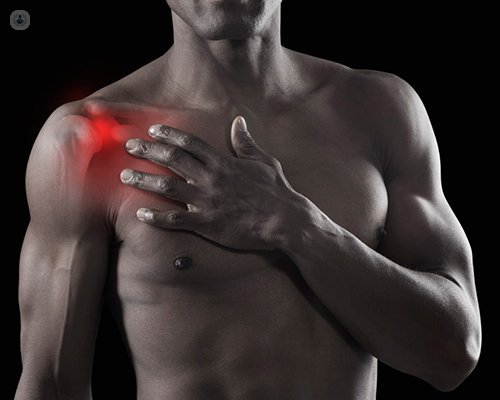Shoulder arthroscopy: how it is used in surgery
Written by:
What is arthroscopy of the shoulder?
An arthroscopy of the shoulder is when a camera is placed inside the shoulder joint, allowing visualisation of the structures of the shoulder. Additionally, procedures can be performed using the camera and instruments to treat pathology.
The camera and instruments are introduced through small incisions (approximately 1 cm) around the shoulder. The surgeon can then view the inside of the shoulder on a TV screen and work accordingly.

What conditions is shoulder arthroscopy used for?
An arthroscopy is used to assess the structures of the shoulder. It can therefore be a diagnostic tool and help support the findings of a clinical examination or imaging studies that have been undertaken (e.g. x-ray, ultrasound, and MRI). It can also be helpful when such studies have not found an obvious cause for a problem.
If pathology is identified, treatment of the condition can then be undertaken.
Conditions that can be treated include:
- Subacromial bursitis and impingement: the inflammation is removed and the area decompressed (subacromial decompression)
- Rotator cuff pathology including tears: tendon tears can be repaired
- Acromioclavicular joint pathology: the joint can be excised and the inflammation removed
- Biceps pathology: the tendon can be released or reinserted into the bone
- Shoulder instability / dislocation: stabilisation of the shoulder joint can be undertaken
- Frozen shoulder: release of adhesive capsulitis (frozen shoulder) can be performed to reduce pain and increase movement.
What are the risks of the procedure?
The risks of the procedure are very small given that this is keyhole surgery. The risks of bleeding, infection, nerve injury, stiffness and thrombosis are around 1%. These risks are always discussed before surgery and further explained.
There may also be risks associated with a specific procedure, which would be highlighted.
The success rate of any surgery, or other available treatment options, are also discussed.
How is the procedure carried out?
A shoulder arthroscopy can be performed with either the patient lying on their side (lateral decubitus) or sat up in a beach chair type position. My personal preference is for the beach chair position.
Surgery can be performed under general anaesthetic augmented with local or regional anaesthesia. Regional anaesthesia can make the whole arm feel numb after the procedure for several hours, but can provide good pain relief. On occasion, a regional anaesthetic alone is preferred, combined with sedation.


